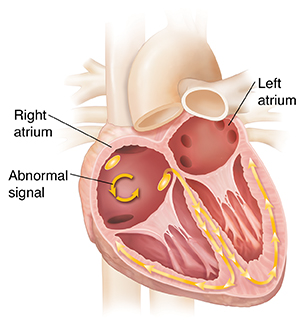Understanding Atrial Flutter
An arrhythmia is any problem with the speed or pattern of the heartbeat. Atrial flutter is a type of arrhythmia. It causes the heart to beat faster than normal. Atrial flutter can increase the risk for certain serious problems, such as stroke. Your healthcare provider will need to monitor and manage it.
What happens during atrial flutter?
The heart has an electrical system that sends signals to control the heartbeat. As signals move through the heart, they tell the heart’s upper chambers (atria) and lower chambers (ventricles) when to squeeze (contract) and relax. This lets blood move through the heart and out to the body and lungs.
With atrial flutter, an abnormal electrical loop (circuit) causes the atria to contract too quickly. This results in a fast, steady heartbeat. Because the atria are not contracting normally, blood may pool in the atria instead of moving into the ventricles. This can increase the risk for blood clots and stroke. The ventricles also contract too quickly. As a result, they may not pump blood to the body and lungs as well as they should. This can weaken the heart muscle over time and cause heart failure.

What causes of atrial flutter?
Many things can cause atrial flutter. They include:
-
Coronary artery disease
-
Heart valve disease
-
Heart attack
-
Heart surgery
-
High blood pressure
-
Thyroid disease
-
Diabetes
-
Lung disease
-
Sleep apnea
-
Heavy alcohol use
-
Older age
What are the symptoms of atrial flutter?
Atrial flutter may or may not cause symptoms. If symptoms do occur, they may include:
How is atrial flutter treated?
Treatment for atrial flutter may include any of the options below.
-
Medicines. You may be prescribed:
-
Heart rate medicines to help slow down the heartbeat
-
Heart rhythm medicines to help the heart beat more regularly
-
Anti-clotting medicines to help reduce the risk for blood clots and stroke
-
Electrical cardioversion. Your healthcare provider uses special pads or paddles to send one or more brief electrical shocks to the heart. This can help reset the heartbeat to normal.
-
Ablation. A long thin tube (catheter) is threaded through a blood vessel to the heart. There, the catheter sends out hot or cold energy to the areas causing the abnormal signals. This energy destroys the problem tissue or cells and cures atrial flutter.
-
AV node ablation. If the heart rate and rhythm can’t be controlled through a traditional ablation or other treatments, you may need an ablation of your AV node. The AV node is the part of the heart that electrically connects the top and bottom chambers of the heart. When this is ablated, the bottom chambers of the heart no longer receive electrical signals from the top. You'll need to have a pacemaker implanted so the bottom chambers of your heart beat correctly.
What are possible complications of atrial flutter?
These can include:
When should I call my healthcare provider?
Call your healthcare provider right away if you have any of these:
Online Medical Reviewer:
Anne Clayton APRN
Online Medical Reviewer:
Stacey Wojcik MBA BSN RN
Online Medical Reviewer:
Steven Kang MD
Date Last Reviewed:
1/1/2022
© 2000-2024 The StayWell Company, LLC. All rights reserved. This information is not intended as a substitute for professional medical care. Always follow your healthcare professional's instructions.